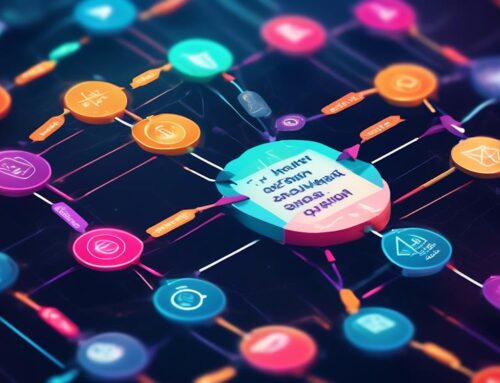In a world where remote work has become the new norm, the need for efficient and reliable data entry solutions has never been greater. Whether you’re a small business owner, a freelancer, or simply someone looking to streamline their data management process, it’s essential to stay up-to-date with the top remote data entry solutions available. From cloud-based platforms that offer flexibility and accessibility to collaboration tools that enhance productivity, there are several options to choose from. But which ones are the best? In this discussion, we will explore 8 of the top remote data entry solutions that you must know, each offering unique features and benefits that can revolutionize your data management experience. So, let’s dive in and discover the future of remote data entry together.
Cloud-Based Platforms
Cloud-based platforms offer a flexible and efficient solution for remote data entry. With cloud-based storage, you can access your data from anywhere with an internet connection. This means you can work on your data entry tasks from the comfort of your home, a coffee shop, or even while traveling. The convenience of remote access allows you to stay productive and complete your work on the go.
Cloud-based platforms provide a secure and reliable way to store your data. Your information is stored in data centers that have robust security measures in place, protecting it from unauthorized access. This ensures the safety of your data and gives you peace of mind.
In addition to security, cloud-based platforms offer scalability. You can easily expand your storage capacity as your data entry needs grow. This eliminates the need to invest in expensive hardware or worry about running out of storage space.
Furthermore, cloud-based platforms often come with advanced features that enhance your data entry experience. These can include automated data validation, real-time collaboration, and integration with other software applications.
Data Security Measures
To ensure the security of your data, it is important to implement robust measures. One crucial measure is data encryption. By encrypting your data, you can protect it from unauthorized access. Encryption converts your data into an unreadable format, which can only be decrypted with the appropriate key. This ensures that even if your data is intercepted, it remains secure and confidential.
In addition to data encryption, access control is another essential security measure. Access control allows you to manage who can access your data and what actions they can perform. By implementing access control mechanisms, you can enforce strict authentication and authorization protocols. This means that only authorized individuals can access your data, reducing the risk of data breaches and unauthorized disclosure.
To further enhance data security, it is recommended to use strong passwords, regularly update software and systems, and implement multi-factor authentication. These additional measures can help safeguard your data and prevent unauthorized access.
Collaboration Tools
Collaboration tools are essential for remote data entry teams to work efficiently. Efficient file sharing allows team members to easily access and update documents in real time. Real-time communication tools enable instant messaging, video conferencing, and screen-sharing, facilitating seamless collaboration. Streamlined task management tools help assign and track tasks, ensuring that the team stays organized and productive.
Efficient File Sharing
Efficiently share files with your team using advanced collaboration tools. These tools enable remote access to files, ensuring that your team can access and work on files from anywhere, at any time. Here are three collaboration tools that can help you streamline file sharing:
- Google Drive: With Google Drive, you can store, share, and collaborate on files in real-time. It allows multiple team members to work on the same document simultaneously, ensuring data accuracy and eliminating the need for version control.
- Dropbox: Dropbox provides a secure and easy-to-use platform for file sharing and collaboration. It offers features like file syncing, version history, and file recovery, making it convenient to share and access files remotely.
- Microsoft OneDrive: OneDrive integrates seamlessly with Microsoft Office applications, allowing teams to collaborate on documents, spreadsheets, and presentations. It offers robust file sharing and syncing capabilities, ensuring efficient collaboration and data accuracy.
Real-Time Communication
Streamline communication and collaboration with real-time communication tools that enable seamless interaction among team members. In the context of remote work challenges, real-time communication is crucial for maintaining effective communication and fostering collaboration within a distributed team. These tools allow team members to communicate instantly, facilitating quick decision-making and problem-solving. Real-time communication tools such as video conferencing platforms, instant messaging apps, and project management software with built-in chat features provide a virtual space for real-time discussions, file sharing, and collaboration. They help bridge the physical distance between team members, promoting better understanding, engagement, and productivity. With real-time communication tools, remote teams can overcome the challenges of communication barriers and time zone differences, enabling efficient and synchronized collaboration regardless of geographical locations.
Streamlined Task Management
Now let’s focus on improving task management and collaboration by utilizing effective tools. When managing a remote workforce, it is crucial to have streamlined task management processes in place to ensure productivity and efficiency. Here are three essential collaboration tools that can aid in achieving this goal:
- Task Automation Platforms: These tools allow you to automate repetitive tasks, such as data entry or file organization, saving time and reducing errors. With features like task templates and workflows, you can streamline your team’s work and ensure consistency.
- Project Management Software: This tool helps you organize and track tasks, deadlines, and progress. It enables real-time communication, assigns responsibilities, and provides clear visibility into project statuses.
- Document Collaboration Tools: These tools facilitate seamless collaboration on shared documents, allowing multiple team members to work simultaneously. They provide version control, commenting features, and real-time updates, ensuring that everyone is on the same page.
Efficiency Enhancement Strategies
To enhance efficiency, consider implementing various strategies in your remote data entry processes. Effective team collaboration is crucial for remote data entry projects. Encourage open communication among team members to ensure smooth workflow and timely completion of tasks. Utilize collaboration tools such as project management software and communication platforms to facilitate real-time communication and file sharing. This will minimize delays and errors in the data entry process. Additionally, effective time management is essential for improving efficiency. Set clear deadlines for each task and establish a prioritization system to ensure that important tasks are completed first. Consider using time tracking tools to monitor productivity and identify areas for improvement. Break down complex tasks into smaller, manageable subtasks to increase productivity and reduce overwhelm. Moreover, establish a routine and allocate specific time slots for different data entry tasks. This will help you stay focused and avoid distractions. Regularly evaluate and optimize your processes to identify bottlenecks and implement improvements. By implementing these efficiency enhancement strategies, you can streamline your remote data entry processes and improve overall productivity.
Quality Control Implementation
To ensure the accuracy and reliability of your remote data entry processes, it is important to implement a comprehensive quality control system. This will help you maintain high standards and minimize errors in your data entry. Here are three key quality control measures you should consider implementing:
- Double Data Entry: Require your remote data entry operators to enter each data point twice. By comparing the two entries, you can identify and rectify any discrepancies or errors. This method helps improve data entry accuracy and ensures that mistakes are caught and corrected before they cause any issues.
- Regular Audits: Conduct regular audits of your remote data entry processes to identify any recurring errors or areas where improvement is needed. This can involve reviewing a sample of completed entries, comparing them with the source documents, and checking for any inaccuracies or inconsistencies. Audits help you identify trends and patterns in errors, allowing you to implement targeted training or process improvements.
- Error Reporting and Resolution: Establish a system for your remote data entry operators to report any errors or issues they encounter. This can be a simple form or an online platform where they can document the error, its impact, and any suggestions for improvement. By encouraging open communication and providing a mechanism for resolution, you can address errors promptly and implement corrective actions.
Scalable Solutions
When it comes to scalable solutions for remote data entry, there are several key points to consider. First, cost-effective scalability allows your organization to easily adjust resources as needed, ensuring efficient operations without overspending. Second, streamlined data management ensures that information is organized and accessible, facilitating smooth workflows and reducing errors. Finally, implementing scalable solutions can significantly increase productivity and efficiency, allowing your team to accomplish more in less time.
Cost-Effective Scalability
Implementing scalable solutions for cost-effective data entry is crucial for maximizing efficiency and minimizing expenses. To achieve this, consider the following strategies:
- Leverage cost-effective outsourcing: By outsourcing your data entry tasks to remote teams, you can tap into a global talent pool and access skilled workers at a lower cost. This allows you to scale your operations without incurring excessive expenses.
- Optimize remote team management: Effective management of your remote data entry team is essential for cost-effective scalability. Use project management tools, establish clear communication channels, and provide ongoing training and support to ensure productivity and minimize errors.
- Implement automation and technology: Embracing automation and utilizing technology can significantly enhance the scalability and cost-effectiveness of your data entry processes. Explore options such as data extraction software, optical character recognition (OCR) tools, and intelligent data capture solutions to streamline operations and reduce manual effort.
Streamlined Data Management
Consider streamlining your data management processes to achieve scalability and efficiency in your operations. One way to achieve this is through data entry automation. By automating the data entry process, you can eliminate the need for manual data entry, reducing the risk of errors and improving data accuracy. Automation also allows for faster data processing, freeing up valuable time for your team to focus on more important tasks. Additionally, implementing streamlined data management solutions can help improve data accuracy. By centralizing and organizing your data in a structured manner, you can ensure that information is easily accessible and up to date. This not only improves the efficiency of your operations but also enhances decision-making capabilities. With streamlined data management, you can achieve scalability and accuracy in your data entry processes.
Increased Productivity and Efficiency
Increase your productivity and efficiency with scalable solutions for data management. When it comes to remote data entry, utilizing the right tools and strategies can greatly enhance your team’s performance. Here are three ways scalable solutions can help you achieve increased accuracy and effective remote team management:
- Automation: Implementing automated data entry processes reduces the time and effort required for manual data entry, allowing your team to focus on more important tasks.
- Cloud-based Platforms: Cloud-based data entry platforms enable real-time collaboration and access to data from anywhere, streamlining communication and enhancing productivity.
- Task Distribution: Scalable solutions offer efficient task distribution features, allowing you to assign data entry tasks to specific team members based on their skills and availability, ensuring optimal utilization of resources.
Use of Advanced Technology
Leverage the power of cutting-edge technology to streamline your remote data entry process. Advanced automation is a game-changer when it comes to overcoming remote work challenges in data entry. With the use of advanced technology, you can automate repetitive tasks, reduce errors, and improve overall efficiency.
One of the key benefits of advanced automation is the ability to automate data entry tasks. Manual data entry can be time-consuming and prone to errors. By implementing advanced technology, you can minimize human involvement and rely on automated processes to enter data accurately and quickly.
Moreover, advanced technology also allows for real-time data synchronization. With remote data entry, it is crucial to have up-to-date information accessible to all team members. Advanced technology ensures that the data is synchronized in real-time, enabling seamless collaboration and decision-making.
Additionally, advanced automation tools often come with built-in data validation and error-checking mechanisms. These features help identify and rectify errors in the data, ensuring data integrity and accuracy.
Cost Effectiveness
With the streamlined processes and efficiency brought about by advanced technology, remote data entry solutions offer a cost-effective approach to managing data entry tasks. By utilizing these solutions, you can implement various cost saving measures and take advantage of budget friendly options. Here are three ways remote data entry solutions can help you save money:
- Reduced Infrastructure Costs: Remote data entry eliminates the need for physical infrastructure, such as office space, equipment, and maintenance. You can save a significant amount of money by eliminating these expenses and opting for a virtual setup.
- Lower Labor Costs: Remote data entry solutions allow you to hire data entry professionals from anywhere in the world. This gives you access to a global talent pool and allows you to hire skilled professionals at lower wages. By reducing labor costs, you can allocate your budget to other critical areas of your business.
- Improved Efficiency and Accuracy: Remote data entry solutions automate repetitive tasks and minimize human errors. With advanced technology and software, data entry processes become faster and more accurate. This not only saves time but also reduces the need for costly error correction and rework.
Frequently Asked Questions
Can Remote Data Entry Solutions Be Customized to Fit the Specific Needs and Requirements of My Business?
Yes, remote data entry solutions can be customized to fit your specific needs and requirements. This allows you to maximize the benefits of remote data entry and streamline your business processes.
How Long Does It Typically Take to Implement a Remote Data Entry Solution?
Implementing a remote data entry solution typically takes a few weeks, depending on the complexity of your business processes. To ensure a smooth implementation, follow best practices such as thorough planning, effective communication, and training your team.
Are There Any Limitations or Restrictions on the Types of Data That Can Be Entered Remotely?
There may be limitations or restrictions on the types of data that can be entered remotely. Data entry security and remote data entry challenges are factors to consider when determining these limitations.
What Measures Are in Place to Ensure Data Accuracy and Prevent Errors in Remote Data Entry?
To ensure data accuracy and prevent errors in remote data entry, measures like double-checking entries, using validation checks, and implementing automated error detection systems are in place. These measures guarantee precise and error-free data.
Can Remote Data Entry Solutions Integrate With Other Existing Software Systems or Databases?
Yes, remote data entry solutions can integrate with existing software systems or databases. They offer various integration options to streamline data transfer and ensure data security measures are in place.




